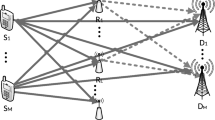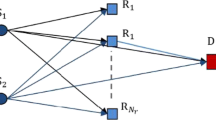Abstract
In this paper, we investigate a large cooperative wireless network with relay nodes, in which cooperation is enabled through physical-layer network coding (PLNC). Specifically, we study the impact of the relay selection on the network capacity with power constraints in two scenarios. First, we consider the basic PLNC model (a.k.a., the ARB model), in which one pair of source nodes (A, B) exchange messages via a selected relay node (R). Given the power constraint, we derive the optimal relay selection and power allocation that maximize the sum capacity, defined as the summation of the capacity for two source-destination channels. Based on results obtained above, we then consider a more general scenario with multiple pairs of source nodes. Assuming the constant power constraint, we derive the upper bound of the minimal sum capacity of any source pair. The optimal power allocation among multiple source pairs is also derived. To validate these theoretical results, we also provide two relay selection strategies: a modified optimal relay assignment strategy and a novel middle point strategy for maximizing the minimal sum capacity of any source pair.









Similar content being viewed by others
References
Fu, S., Lu, K., Zhang, T., Qian, Y., & Chen, H.-H. (2010). Cooperative wireless networks based on physical layer network coding. IEEE Wireless Communications, 17(6), 86–95.
Zhang, S., Liew, S. C., & Lam P. P. (2006). Physical-layer network coding. InProceedings of the 12th annual international conference on mobile computing and networking (pp. 358–365).
Popovski, P., & Yomo, H. (2007). Wireless network coding by amplify-and-forward for bi-directional traffic flows. IEEE Communications Letters, 11(1),16–18.
Katti, S., Gollakota, S., & Katabi, D. (2007). Embracing wireless interference: Analog network coding. SIGCOMM Computer Communication Review, 37(4), 397–408.
Lu, K., Fu, S., Qian, Y., & Chen, H.-H. (2009). On capacity of random wireless networks with physical-layer network coding. IEEE Journal on Selected Areas in Communications, 27(5),763–772.
Host-Madsen, A., & Zhang, J. (2005). Capacity bounds and power allocation for wireless relay channels. IEEE Transactions on Information Theory, 51(6), 2020–2040.
Cover, T., & Gamal, A. E. (1979). Capacity theorems for the relay channel. IEEE Transactions on Information Theory, 25(5),572–584.
Kramer, G., Gastpar, M., & Gupta, P. (2005). Cooperative strategies and capacity theorems for relay networks. IEEE Transactions on Information Theory, 51(9), 3037–3063.
Zhao, Y., Adve, R., & Lim, T. J. (2007). Improving amplify-and-forward relay networks: optimal power allocation versus selection. IEEE Transactions on Wireless Communications, 6(8), 3114–3123.
Chen, M., Serbetli, S., & Yener, A. (2008). Distributed power allocation strategies for parallel relay networks. IEEE Transactions on Wireless Communications, 7(2), 552–561.
Nam, S., Vu, M., & Vahid, T. (2008). Relay selection methods for wireless cooperative communications. 42nd Annual Conference on Information Sciences and Systems (pp. 859–864).
Yang, D., Fang, X., & Xue, G. (2011). OPRA: Optimal relay assignment for capacity maximization in cooperative networks. In Proceedings of IEEE international conference on communications (pp. 1–6).
Shi, Y., Sharma, S., Hou, Y. T., & Kompella, S. (2008). Optimal relay assignment for cooperative communications. In Porceedings of the 9th ACM International Symposium on Mobile ad-hoc Networking and Computing (pp. 3–12).
Wilson, M. P., & Narayanan, K. (2009). Power allocation strategies and lattice based coding schemes for bi-directional relaying. IEEE International Symposium on Information Theory (pp. 344–348).
Talwar, S., Jing, Y., & Shahbazpanahi, S. (2011). Joint relay selection and power allocation for two-way relay networks. IEEE Signal Processing Letters, 18(2), 91–94.
Vardhe, K., Reynolds, D., & Woerner, B. (2011). Joint power allocation and relay selection for multiuser cooperative communication. IEEE Transactions on Wireless Communications, 9(4), 1255–1260.
Kivanc, D., Li, G., & Liu,H. (2003). Computationally efficient bandwidth allocation and power control for OFDMA. IEEE Transactions on Wireless Communications, 2(6), 1150–1158.
Nam, W., Chung, S., & Lee, Y. H. (2008). Capacity bounds for two-way relay channels. In Proceedings of IEEE international Zurich seminar on communications, 144-147.
Rappaport, T. S. (2002). Wireless communications: Principles and practice. Upper Saddle River, NJ: Prentice Hall PTR.
Li, Z., & Erkip, E. (2005). Relay search algorithms for coded cooperative systems. In Proceedings of IEEE global telecommunications conference. doi:10.1109/GLOCOM.2005.1577865.
Lichte, H., Valentin, S., & Karl, H. (2010). Expected interference in wireless networks with geometric path loss: A closed-form approximation. IEEE Communications Letters, 14(2), 130–132.
Viswanath, P., Tse, D. N., & Anantharam, V. (2000). Asymptotically optimal waterfilling in multiple antenna multiple access channels. In Proceedings of IEEE International Symposium on Information Theory. doi:10.1109/ISIT.2000.866764.
Yu, W., Rhee, W., & Cioffi, J. M. (2001). Optimal power control in multiple access fading channels with multiple antennas. In Proceedings of IEEE international conference on communications (pp. 575–579).
Li, W., Li, J., & Fan, P. (2009). Optimal data rate and opportunistic scheme on network coding over Rayleigh fading channels. In Proceedings of international conference on mobile ad-hoc and sensor networks (pp. 257–264).
Boyd S. P., & Vandenberghe L. (2004). Convex optimization. Cambridge: Cambridge University Press.
Author information
Authors and Affiliations
Corresponding author
Appendices
Appendix 1
Here we give the detailed proof of Lemma 2 in Sect. 3 Considering a relay node R that resides along line AO, we denote d AR = d, d ≤ s. Then d BR = 2s − d and \(\gamma=\frac{2s-d}{d}.\) According to the problem defined in (7), we aim to find the optimal d to maximize: \(C_{trans}=\min\{1+\frac{P_A}{d^n\sigma^2}, 1+\frac{P_R}{(2s-d)^n\sigma^2}\}\times \min\{1+\frac{P_B}{(2s-d)^n\sigma^2}, 1+\frac{P_R}{d^n\sigma^2}\}.\) For the problem solving, it needs to analyze four cases: (1)\(\frac{P_A}{d^n}\leq \frac{P_R}{(2s-d)^n}, \frac{P_B}{(2s-d)^n}\leq \frac{P_R}{d^n}; \) (2)\(\frac{P_A}{d^n}\le\frac{P_R}{(2s-d)^n},\frac{P_B}{(2s-d)^n}\le\frac{P_R}{d^n};\) (3)\(\frac{P_A}{d^n}\ge\frac{P_R}{(2s-d)^n},\frac{P_B}{(2s-d)^n}\le\frac{P_R}{d^n};\) (4)\(\frac{P_A}{d^n}\ge\frac{P_R}{(2s-d)^n},\frac{P_B}{(2s-d)^n}\ge\frac{P_R}{d^n}.\)
Typically, when the relay node locates at the middle point O with d = s and with \(P_A=P_B=P_R=\frac{P}{3},\) we have \(C_{trans}^*=1+\frac{2P}{3s^n\sigma^2}+\frac{P^2}{9s^{2n}\sigma^4}.\) We aim to prove that such C * trans is the maximal value that can only be achieved at the middle point O. The details of the analysis of above four cases are shown as follows.
Case (1): We denote C trans as
Note in this case, P R is not the bottleneck. There are only two subcases to maximize C 1: (1) \(P_A = \left(\frac{d}{2s-d}\right)^nP_R; \) (2) \(P_B = \left(\frac{2s-d}{d}\right)^nP_R.\) We first consider the subcase \(P_A = \left(\frac{d}{2s-d}\right)^nP_R, \) which yields \(P_B=P-P_R-P_A=P-\left[ 1+\frac{d^n}{(2s-d)^n}\right]P_R\leq \frac{(2s-d)^n}{d^n}P_R.\) Hence, we have
For a given P, Eq. 12 is maximized with P * R where \(P_R^* = (P-d^n\sigma^2)\frac{(2s-d)^n}{2\left[(2s-d)^n+d^n\right]}\) which gives \(P_A^* = (P-d^n\sigma^2)\frac{d^n}{2\left[(2s-d)^n+d^n\right]}, P_B^* = \frac{P+d^n\sigma^2}{2}.\) Hence, we have
Since d ≤ s, it is easy to show that d n + (2s − d)n monotonically decreases with the increase of d, which shows that C *1 is monotonically increasing with d. We then conclude that C *1 achieve the maximum when d = s and \({C_1^*}_{max} = \left(1+\frac{P-s^n}{4s^n\sigma^2}\right)\left(1+\frac{P+s^n} {2s^n\sigma^2}\right).\) It is easy to show that \({C_1^*}_{max} < C_{trans}^* = 1 + \frac{2P}{3s^n\sigma^2}+\frac{P^2}{9s^{2n}\sigma^2}.\)
Next, we consider the subcase of \(P_B=\left(\frac{2s-d}{d}\right)^nP_R, \) which immediately gives us \(P_A=P-P_R-P_B=P-\left[1+\left(\frac{2s-d}{d}\right)^n\right]P_R \le \frac{d}{(2s-d)})^nP_R.\) Therefore, we have \( P_R \geq \frac{P}{1+\left(\frac{d}{2s-d}\right)^n+ \left(\frac{2s-d}{d}\right)^n}\) and
To maximize Eq. 14, we have \(P_R^{\Updelta} = \frac{d^n}{2\left[(2s-d)^n+d^n\right]}\left[P-(2s-d)^n\sigma^2\right].\) We can show that for \(P_R^{\Updelta}\), the corresponding \(C_1^\Updelta \leq C_1^*\) in Eq. 13, thus \(C_1^\Updelta\leq C_{trans}^*\). In all, C 1 ≤ C * trans .
Case (2): We denote C trans as C 2. Since P B is not the bottleneck there are only two cases to maximize \(C_2: 1) P_A = \left(\frac{d}{2s-d}\right)^nP_R; 2) P_R = \left(\frac{d}{2s-d}\right)^nP_B.\) With the similar approach shown in case (1), we can prove that C 2 ≤ C * trans .
Case (3): We denote C trans as \(C_3=1+\frac{P_R}{(2s-d)^n\sigma^2}+\frac{P_B}{(2s-d)^n\sigma^2} +\frac{P_RP_B}{(2s-d)^{2n}\sigma^4}.\) It is easy to see that the C 3 will increase with d and will reach the maximum when d = s no matter how the power budget is allocated among the three nodes.
Case (4): We denote C trans as \(C_4=1+\frac{P_R}{d^n\sigma^2}+\frac{P_R}{(2s-d)^n\sigma^2} +\frac{P_R^2}{d^n(2s-d)^n\sigma^4}.\) Obviously in such case, \(P=P_A+P_B+P_R\ge \frac{d^n}{(2s-d)^n}P_R+\frac{(2s-d)^n}{d^n}P_R+P_R\) so that \(P_R\le \frac{P}{1+(\frac{d}{2s-d})^n+(\frac{2s-d}{d})^n}.\) Therefore, we have
which yields C 4 ≤ C * trans . In all, considering relay nodes that reside along line AO, C * trans can only be achievable when the relay is at the middle point O, which is the best relay selection.
Appendix 2
Here we give the detailed proof of Theorem 2 in Sect. 3 To solve the problem defined in Eq. 4, it can apply the convex optimization technique after certain problem transformation. In particular, we define two assistant non-negative variables C 1 and C 2 as \(C_1=\min \{\log(1+\frac{P_A}{d^n\sigma^2}), \log(1+\frac{P_{R^i}}{\gamma^nd^n\sigma^2})\}\) and \(C_2=\min \{\log(1+\frac{P_B}{\gamma^nd^n\sigma^2}), \log(1+\frac{P_{R^i}}{d^n\sigma^2})\}.\) Then the problem can be transformed into the convex problem as follows.
subject to:
Obviously, we have the Lagrangian function as \(L=-C_1-C_2+\lambda_1(C_1-\log(1+\frac{P_A}{d^n\sigma^2})) +\lambda_2(C_1-\log(1+\frac{P_{R^i}}{\gamma^nd^n\sigma^2})) +\lambda_3(C_2-\log(1+\frac{P_B}{\gamma^nd^n\sigma^2})) +\lambda_4(C_2-\log(1+\frac{P_{R^i}}{d^n\sigma^2})) +\lambda_5(-C_1)+\lambda_6(-C_2)+\lambda_7(-P_A)+\lambda_8(-P_B) +\lambda_9(-P_{R^i})+v_1(P_A+P_B+P_{R^i}-P)\) where \(\lambda_i\ge 0, i=1,2,\ldots,9.\) According to the complementary slackness related to the convex optimization, it’s easy to derive that \(\lambda_5,\ldots,\lambda_9\) is 0. Moreover, by applying the KKT optimality conditions in the convex optimization [25], we will have to take the partial derivative of L with respect to each of five variables and set each derivation to 0. The whole equation set related to the KKT conditions is shown as follows:
By solving the above equation set, the optimal power allocation and the corresponding maximal sum capacity can be obtained as in Theorem 2.
Rights and permissions
About this article
Cite this article
Zheng, Z., Fu, S., Lu, K. et al. On the relay selection for cooperative wireless networks with physical-layer network coding. Wireless Netw 18, 653–665 (2012). https://doi.org/10.1007/s11276-012-0425-4
Published:
Issue Date:
DOI: https://doi.org/10.1007/s11276-012-0425-4




